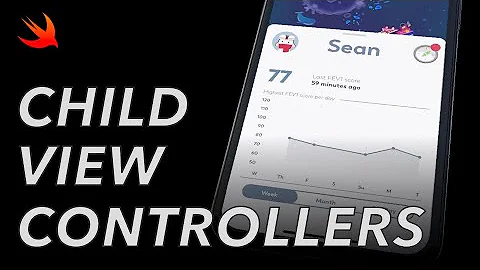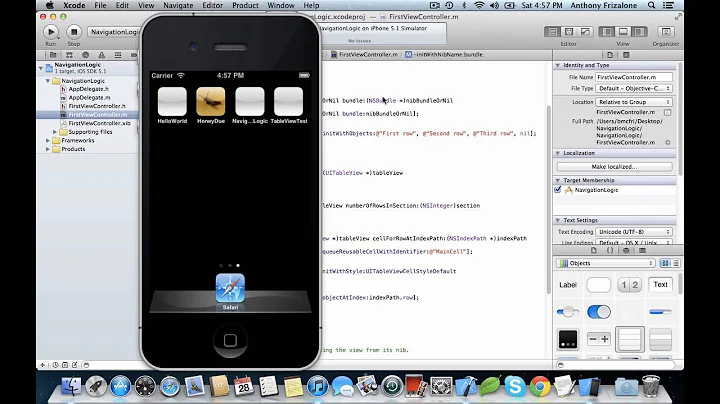How can I pop a view from a UINavigationController and replace it with another in one operation?
Solution 1
I've discovered you don't need to manually mess with the viewControllers property at all. Basically there are 2 tricky things about this.
self.navigationControllerwill returnnilifselfis not currently on the navigation controller's stack. So save it to a local variable before you lose access to it.- You must
retain(and properlyrelease)selfor the object who owns the method you are in will be deallocated, causing strangeness.
Once you do that prep, then just pop and push as normal. This code will instantly replace the top controller with another.
// locally store the navigation controller since
// self.navigationController will be nil once we are popped
UINavigationController *navController = self.navigationController;
// retain ourselves so that the controller will still exist once it's popped off
[[self retain] autorelease];
// Pop this controller and replace with another
[navController popViewControllerAnimated:NO];
[navController pushViewController:someViewController animated:NO];
In that last line if you change the animated to YES, then the new screen will actually animate in and the controller you just popped will animate out. Looks pretty nice!
Solution 2
The following approach seems nicer to me, and also works well with ARC:
UIViewController *newVC = [[UIViewController alloc] init];
// Replace the current view controller
NSMutableArray *viewControllers = [NSMutableArray arrayWithArray:[[self navigationController] viewControllers]];
[viewControllers removeLastObject];
[viewControllers addObject:newVC];
[[self navigationController] setViewControllers:viewControllers animated:YES];
Solution 3
From experience, you're going to have to fiddle with the UINavigationController's viewControllers property directly. Something like this should work:
MyEditViewController *mevc = [[MYEditViewController alloc] initWithGizmo: gizmo];
[[self retain] autorelease];
NSMutableArray *controllers = [[self.navigationController.viewControllers mutableCopy] autorelease];
[controllers removeLastObject];
self.navigationController.viewControllers = controllers;
[self.navigationController pushViewController:mevc animated: YES];
Note: I changed the retain/release to a retain/autorelease as that's just generally more robust - if an exception occurs between the retain/release you'll leak self, but autorelease takes care of that.
Solution 4
After much effort (and tweaking the code from Kevin), I finally figured out how to do this in the view controller that is being popped from the stack. The problem that I was having was that self.navigationController was returning nil after I removed the last object from the controllers array. I think it was due to this line in the documentation for UIViewController on the instance method navigationController "Only returns a navigation controller if the view controller is in its stack."
I think that once the current view controller is removed from the stack, its navigationController method will return nil.
Here is the adjusted code that works:
UINavigationController *navController = self.navigationController;
MyEditViewController *mevc = [[MYEditViewController alloc] initWithGizmo: gizmo];
NSMutableArray *controllers = [[self.navigationController.viewControllers mutableCopy] autorelease];
[controllers removeLastObject];
navController.viewControllers = controllers;
[navController pushViewController:mevc animated: YES];
Solution 5
Thanks, this was exactly what I needed. I also put this in an animation to get the page curl:
MyEditViewController *mevc = [[MYEditViewController alloc] initWithGizmo: gizmo];
UINavigationController *navController = self.navigationController;
[[self retain] autorelease];
[UIView beginAnimations:nil context:NULL]; [UIView setAnimationDuration: 0.7];
[UIView setAnimationTransition:<#UIViewAnimationTransitionCurlDown#> forView:navController.view cache:NO];
[navController popViewControllerAnimated:NO];
[navController pushViewController:mevc animated:NO];
[UIView commitAnimations];
0.6 duration is fast, good for 3GS and newer, 0.8 is still a bit too fast for 3G..
Johan
Related videos on Youtube
joshmcode
Updated on February 27, 2020Comments
-
 joshmcode over 4 years
joshmcode over 4 yearsIf I had a method like below:
public Person GetPerson(int id) { // code that returns a Person where id is == id }Let's also so that Person looks like this:
public class Person { public int id {get; set;} public string firstName {get; set;} public string lastName {get;set} }I know that I could call it like so:
string name = GetPerson(someId).firstName;What is the syntax where I could chain the firstName and lastName together? I am aware that some of the answers might be, "just create a field
fullName" but I am actually just trying to expand my knowledge of C# to see if there is a way to chain those fields together WITHOUT doing this:string name = $"{GetPerson(someId).firstName} {GetPerson(someId).lastName}";Also, I don't want to return the Person object and then combine them. I'd like to (if it is possible) just combine it all in one line with chaining. I've tried several ways and can't get it to compile.
Edit What original prompted me to want to do this was to avoid calling the GetPerson method 2x when using a concatenation approach to getting the full name (when not just creating a variable for this purpose). As was pointed out in the comments by Servy, this is really what variables are for and, as was also pointed out by O. R. Mapper, what I was looking for does not appear to be supported by C# at this time.
-
Servy over 7 yearsStore the person in a variable. This is exactly what they exist for.
-
 Admin over 7 yearsWhat do you mean by "chain"?
Admin over 7 yearsWhat do you mean by "chain"? -
ColinM over 7 yearsWhy not just add a full name property on the object that uses string interpolation or
string.Formatto join the full name? -
ColinM over 7 yearsAlright, ignore the first part of my comment - after seeing your message regarding the
fullNameproperty, but now my question is why are you trying to "expand knowledge" by adding complication? Even the most experienced developers would use a property, otherwise you're adding complication for the sake of adding complication. -
 joshmcode over 7 years@DStanley Nothing at all. As my question states, its just a language question and not a proper-way-to-do-something or practicality question. No panda bears will be saved or lost by this question being answered :-)
joshmcode over 7 years@DStanley Nothing at all. As my question states, its just a language question and not a proper-way-to-do-something or practicality question. No panda bears will be saved or lost by this question being answered :-) -
 trashr0x over 7 yearsFurther to the comments, OP could add "in X language, I would do this:
trashr0x over 7 yearsFurther to the comments, OP could add "in X language, I would do this:showUsHowYouWouldDoIt();" to his post, so it becomes more clear what he's after. -
O. R. Mapper over 7 years@trashr0x: As far as I understood, the OP is looking for some syntax such as
string name = with GetPerson(someId) { firstName + " " + lastName }(which would then return the expression in the braces, with identifiers evaluated in the scopeGetPerson(someId)). I do not think anything to that effect is currently supported by C#, though.
-
-
emmby over 14 yearsbrilliant! much better solution
-
iamj4de about 14 yearsAwesome. Although I didn't need to call [[self retain] autorelease], it still works fine.
-
toxaq over 13 yearsInteresting, my problem seemed to be caused by having the popViewControllerAnimated set to yes. I set it to know and left the push as yes and it looks just fine! Cheers.
-
Martin almost 13 yearsPerhaps an obvious addition, but you can then put the code above in a animation block to animate the transition: [UIView beginAnimations:@"View Flip" context:nil]; [UIView setAnimationDuration:0.80]; [UIView setAnimationCurve:UIViewAnimationCurveEaseInOut]; [UIView setAnimationTransition: UIViewAnimationTransitionFlipFromRight forView:navController.view cache:NO]; [navController pushViewController:newController animated:YES]; [UIView commitAnimations];
-
 David H over 12 yearsYour code is exactly what I used, great! Thanks. One note: with page curl transition I got a white artifice at bottom of view (who knows why) but with flip it worked fine. Anyway, this is nice and compact code!
David H over 12 yearsYour code is exactly what I used, great! Thanks. One note: with page curl transition I got a white artifice at bottom of view (who knows why) but with flip it worked fine. Anyway, this is nice and compact code! -
Ian Terrell over 12 yearsWorks great with ARC just by removing the retain/autorelease line.
-
 nikolovski over 11 yearsThe solution works, except when the UIViewController in question is on top of the stack: than
nikolovski over 11 yearsThe solution works, except when the UIViewController in question is on top of the stack: than[navController popViewControllerAnimated:NO]doesn't work (Apple documentation also states this), and you get two VCs on the stack. I've found that you can call[navController setViewControllers:@[yourViewController]]in that case, and everything should work smoothly. -
JohnK almost 11 years@MarkoNikolovski, it works for me (iOS 6.1). But maybe you mean on the bottom of the stack (i.e., it's the root vc)? If so, you just need to avoid putting this code in the root ViewController. A completely alternative solution would work explicitly with the stack, as seen here.
-
 nikolovski almost 11 years@JohnK, yes, that's correct, my bad. I was basically had in mind the case when there's only one VC, so I didn't think about the top/bottom semantics :)
nikolovski almost 11 years@JohnK, yes, that's correct, my bad. I was basically had in mind the case when there's only one VC, so I didn't think about the top/bottom semantics :) -
zaitsman almost 11 yearsthis causes a warning for me in the console - Finishing up a navigation transition in an unexpected state. Navigation Bar subview tree might get corrupted. Any way to suppress it?
-
zaitsman almost 11 years@LukeRogers, this causes the following warning for me: Finishing up a navigation transition in an unexpected state. Navigation Bar subview tree might get corrupted. Any way to suppress it?
-
LAOMUSIC ARTS over 10 yearsUsing this solution, you overwrite the popover. And to show in the DetailView, your code should read:
if(indexPath.row == 0){UIViewController *newVC = [[UIViewController alloc] init];newVC = [self.storyboard instantiateViewControllerWithIdentifier:@"Item1VC"]; NSMutableArray *viewControllers = [NSMutableArray arrayWithArray:[_detailViewController.navigationController viewControllers]]; [viewControllers removeLastObject];[viewControllers addObject:newVC]; [_detailViewController.navigationController setViewControllers:viewControllers animated:YES];} -
LAOMUSIC ARTS over 10 yearsThis gives me a black whole !
-
JERC almost 10 yearsWhat I was looking for.
-
Alex Wayne almost 10 years@TomerPeled Yeah this answer is nearly 5 years old... I think that was the case in like iOS 3. The APIs have changed enough that I'm not sure it's the best answer anymore.
-
Tomer Peled almost 10 yearsActually for now the solution which @Luke Rogers offered below works good.
-
Servy over 7 yearsNow you're getting the person twice, rather than once. Also, this isn't really any different than the OP's code, and has all of the same problems.
-
Servy over 7 yearsBut this is explicitly declaring variables, the variables are just parameters to a method instead of a local variable, but they're both variables.
-
Servy over 7 yearsBut you do.
p. It's a variable of typePerson, that you've declared. -
 Evk over 7 yearsWell anyway author just wants to explore options, and this is one option. However I removed a note about explicit variables.
Evk over 7 yearsWell anyway author just wants to explore options, and this is one option. However I removed a note about explicit variables. -
 trashr0x over 7 yearsRead the question.
trashr0x over 7 yearsRead the question.






![UINavigationController [THE BEST WAY TO USE IT]](https://i.ytimg.com/vi/MNMWMyQcs_I/hq720.jpg?sqp=-oaymwEcCNAFEJQDSFXyq4qpAw4IARUAAIhCGAFwAcABBg==&rs=AOn4CLCnDrYE7NBvjYuRlIXYO1PlfFv6Zw)




